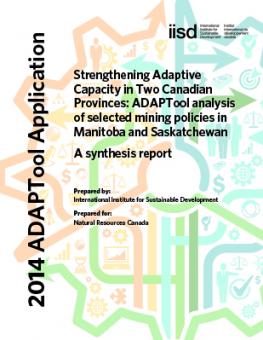
Strengthening Adaptive Capacity in Two Canadian Provinces: ADAPTool analysis of selected mining policies in Manitoba and Saskatchewan: A synthesis report
The Adaptive Design and Policy Assessment Tool (ADAPTool) is an Excel-based online tool developed by the International Institute for Sustainable Development and partners as a structured guide through an assessment process that compares existing policies and programs to the characteristics of adaptive policies.
The ADAPTool assesses policies or programs in relation to a defined stressor or external change. It produces two kinds of assessments: 1) it gauges the ability of existing policies or programs to support adaptation measures undertaken in response to the specified stressor by the policy target groups; 2) it assesses the general adaptability of the policies or programs themselves, which is to say, whether they are likely to respond well under the influence of the defined changes as well as under unforeseeable changes in the future. The ADAPtool builds on IISD-led research on Creating Adaptive Policies.
In this pilot application, ADAPtool for existing policies was applied to a suite of six mining-related policies in Manitoba and nine mining-related policies in Saskatchewan. IISD and analysts from mining and other relevant departments from the provinces of Manitoba and Saskatchewan worked together to conduct the ADAPtool analyses, including: initial project scoping (including choice of policies to be analyzed); training on use of ADAPtool; literature review and vulnerability assessments for the forestry-relevant sectors; adaptation analysis, adaptive policy analysis and final reporting on results.
A total of 15 policies were assessed using ADAPTool in the mining sector in Manitoba and Saskatchewan. For both provinces, four mining phases were identified: (1) exploring and siting, (2) development (construction of infrastructure), (3) operations (processing and waste management, extractions) and (4) closure and remediation. The primary stressor of interest in this analysis is climate change; specifically, increased drought, excessive moisture and increased temperatures were identified as climate change stressors of relevance to the mining sector. In Manitoba, 37 vulnerabilities to these climate stressors and a corresponding 48 adaptation actions were identified through literature review and collaborative deliberation. In Saskatchewan, 44 vulnerabilities were identified in the mining sector, with 66 corresponding adaptation actions.
Based on the analyses, both provinces saw a lack of support for actions such as transportation and building-related actions. While climate impacts and risks were fairly significant, there was inadequate emphasis on the use of foresighting and scenario planning methodologies to anticipate these impacts and build mitigation measures into mining policies.